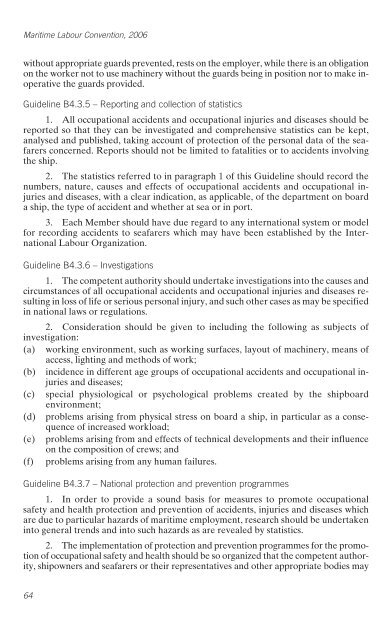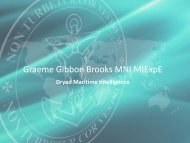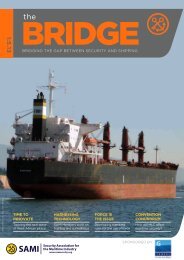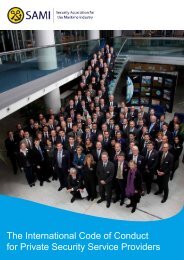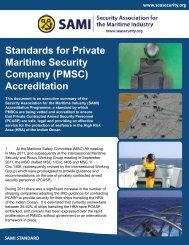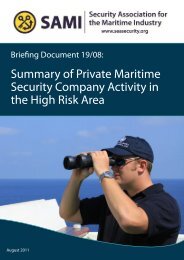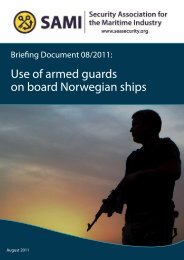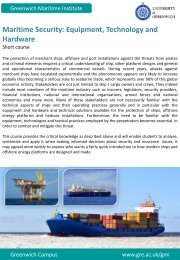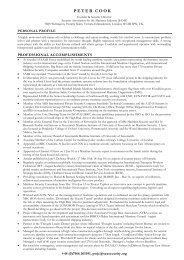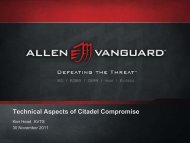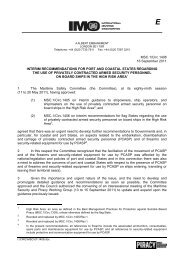Health protection, medical care, welfare <strong>and</strong> social security protectionshould review on an ongoing basis the problem of noise on board ships with the objectiveof improving the protection of seafarers, in so far as practicable, from the adverse effectsof exposure to noise.2. The review referred to in paragraph 1 of this Guideline should take accountof the adverse effects of exposure to excessive noise on the hearing, health <strong>and</strong> comfortof seafarers <strong>and</strong> the measures to be prescribed or recommended to reduce shipboardnoise to protect seafarers. The measures to be considered should include the following:(a) instruction of seafarers in the dangers to hearing <strong>and</strong> health of prolonged exposureto high noise levels <strong>and</strong> in the proper use of noise protection devices <strong>and</strong>equipment;(b) provision of approved hearing protection equipment to seafarers where necessary;<strong>and</strong>(c) assessment of risk <strong>and</strong> reduction of exposure levels to noise in all accommodation<strong>and</strong> recreational <strong>and</strong> catering facilities, as well as engine rooms <strong>and</strong> other machineryspaces.Guideline B4.3.3 – Exposure to vibration1. The competent authority, in conjunction with the competent internationalbodies <strong>and</strong> with representatives of shipowners’ <strong>and</strong> seafarers’ organizations concerned,<strong>and</strong> taking into account, as appropriate, relevant international st<strong>and</strong>ards,should review on an ongoing basis the problem of vibration on board ships with the objectiveof improving the protection of seafarers, in so far as practicable, from the adverseeffects of vibration.2. The review referred to in paragraph 1 of this Guideline should cover the effectof exposure to excessive vibration on the health <strong>and</strong> comfort of seafarers <strong>and</strong> themeasures to be prescribed or recommended to reduce shipboard vibration to protectseafarers. The measures to be considered should include the following:(a) instruction of seafarers in the dangers to their health of prolonged exposure tovibration;(b) provision of approved personal protective equipment to seafarers where necessary;<strong>and</strong>(c) assessment of risks <strong>and</strong> reduction of exposure to vibration in all accommodation<strong>and</strong> recreational <strong>and</strong> catering facilities by adopting measures in accordance withthe guidance provided by the ILO code of practice entitled Ambient factors inthe workplace, 2001, <strong>and</strong> any subsequent revisions, taking account of the differencebetween exposure in those areas <strong>and</strong> in the workplace.Guideline B4.3.4 – Obligations of shipowners1. Any obligation on the shipowner to provide protective equipment or otheraccident prevention safeguards should, in general, be accompanied by provisions requiringtheir use by seafarers <strong>and</strong> by a requirement for seafarers to comply with therelevant accident prevention <strong>and</strong> health protection measures.2. Account should also be taken of Articles 7 <strong>and</strong> 11 of the Guarding of Machinery<strong>Convention</strong>, 1963 (No. 119), <strong>and</strong> the corresponding provisions of the Guarding ofMachinery Recommendation, 1963 (No. 118), under which the obligation to ensurecompliance with the requirement that machinery in use is properly guarded, <strong>and</strong> its use63
<strong>Maritime</strong> <strong>Labour</strong> <strong>Convention</strong>, 2006without appropriate guards prevented, rests on the employer, while there is an obligationon the worker not to use machinery without the guards being in position nor to make inoperativethe guards provided.Guideline B4.3.5 – Reporting <strong>and</strong> collection of statistics1. All occupational accidents <strong>and</strong> occupational injuries <strong>and</strong> diseases should bereported so that they can be investigated <strong>and</strong> comprehensive statistics can be kept,analysed <strong>and</strong> published, taking account of protection of the personal data of the seafarersconcerned. Reports should not be limited to fatalities or to accidents involvingthe ship.2. The statistics referred to in paragraph 1 of this Guideline should record thenumbers, nature, causes <strong>and</strong> effects of occupational accidents <strong>and</strong> occupational injuries<strong>and</strong> diseases, with a clear indication, as applicable, of the department on boarda ship, the type of accident <strong>and</strong> whether at sea or in port.3. Each Member should have due regard to any international system or modelfor recording accidents to seafarers which may have been established by the International<strong>Labour</strong> Organization.Guideline B4.3.6 – Investigations1. The competent authority should undertake investigations into the causes <strong>and</strong>circumstances of all occupational accidents <strong>and</strong> occupational injuries <strong>and</strong> diseases resultingin loss of life or serious personal injury, <strong>and</strong> such other cases as may be specifiedin national laws or regulations.2. Consideration should be given to including the following as subjects ofinvestigation:(a) working environment, such as working surfaces, layout of machinery, means ofaccess, lighting <strong>and</strong> methods of work;(b) incidence in different age groups of occupational accidents <strong>and</strong> occupational injuries<strong>and</strong> diseases;(c) special physiological or psychological problems created by the shipboardenvironment;(d) problems arising from physical stress on board a ship, in particular as a consequenceof increased workload;(e) problems arising from <strong>and</strong> effects of technical developments <strong>and</strong> their influenceon the composition of crews; <strong>and</strong>(f) problems arising from any human failures.Guideline B4.3.7 – National protection <strong>and</strong> prevention programmes1. In order to provide a sound basis for measures to promote occupationalsafety <strong>and</strong> health protection <strong>and</strong> prevention of accidents, injuries <strong>and</strong> diseases whichare due to particular hazards of maritime employment, research should be undertakeninto general trends <strong>and</strong> into such hazards as are revealed by statistics.2. The implementation of protection <strong>and</strong> prevention programmes for the promotionof occupational safety <strong>and</strong> health should be so organized that the competent authority,shipowners <strong>and</strong> seafarers or their representatives <strong>and</strong> other appropriate bodies may64
- Page 8:
C5.1. Flag State responsibilities .
- Page 11 and 12:
the Convention regarding the need f
- Page 13 and 14:
oard ships but are not directly inv
- Page 15 and 16:
supervisory system (a system establ
- Page 18 and 19:
A16. How does the MLC, 2006 make it
- Page 20 and 21:
A19. What will happen to the mariti
- Page 22 and 23:
B. Questions about the workers andt
- Page 27 and 28:
authority?] as qualified to issue s
- Page 29 and 30:
C1.3.b. Does this training requirem
- Page 31 and 32:
It may be useful to also consider t
- Page 33 and 34:
equirements for upgrading or promot
- Page 35 and 36:
C2.3.h. Do the hour of rest and hou
- Page 37 and 38:
C3. Title 3 Accommodation, recreati
- Page 39 and 40:
y berths and lockers, chests of dra
- Page 41 and 42:
C4.1.b. Must every ship have a ship
- Page 43 and 44:
• the cost of safeguarding the pr
- Page 45 and 46:
(b) facilities for sports and outdo
- Page 47 and 48:
• Sickness benefit• Unemploymen
- Page 49 and 50:
agreed upon international standards
- Page 51 and 52:
provisions of Regulation 5.1.3 and
- Page 53 and 54:
C5.1.o. What is the period of valid
- Page 55 and 56:
(b)(c)to carry out any examination,
- Page 57 and 58:
prevents ships being delayed by unn
- Page 59 and 60:
certificate and DMLC should be the
- Page 61 and 62:
C5.2.q. Are complaints confidential
- Page 64 and 65:
INTERNATIONAL LABOUR CONFERENCECont
- Page 66 and 67:
Maritime Labour Convention, 2006MAR
- Page 68 and 69:
Maritime Labour Convention, 2006(b)
- Page 70 and 71:
Maritime Labour Convention, 20062.
- Page 72 and 73:
Maritime Labour Convention, 2006Pla
- Page 74:
Maritime Labour Convention, 20062.
- Page 78: Explanatory note to the Regulations
- Page 82 and 83: Minimum requirements for seafarers
- Page 84 and 85: Minimum requirements for seafarers
- Page 86 and 87: Minimum requirements for seafarers
- Page 88 and 89: Minimum requirements for seafarers
- Page 90 and 91: Conditions of employmentTITLE 2. CO
- Page 92 and 93: Conditions of employmentGuideline B
- Page 94 and 95: Conditions of employment3. National
- Page 96 and 97: Conditions of employment(a) hours o
- Page 98 and 99: Conditions of employment4. Paragrap
- Page 100 and 101: Conditions of employmentRegulation
- Page 102 and 103: Conditions of employment(b) accommo
- Page 104 and 105: Conditions of employmentciently and
- Page 106 and 107: Accommodation, recreational facilit
- Page 108 and 109: Accommodation, recreational facilit
- Page 110 and 111: Accommodation, recreational facilit
- Page 112 and 113: Accommodation, recreational facilit
- Page 114 and 115: Accommodation, recreational facilit
- Page 116 and 117: Accommodation, recreational facilit
- Page 118 and 119: Accommodation, recreational facilit
- Page 120 and 121: Health protection, medical care, we
- Page 122 and 123: Health protection, medical care, we
- Page 124 and 125: Health protection, medical care, we
- Page 126 and 127: Health protection, medical care, we
- Page 130 and 131: Health protection, medical care, we
- Page 132 and 133: Health protection, medical care, we
- Page 134 and 135: Health protection, medical care, we
- Page 136 and 137: Health protection, medical care, we
- Page 138 and 139: TITLE 5. COMPLIANCE AND ENFORCEMENT
- Page 140 and 141: Compliance and enforcement(a) has t
- Page 142 and 143: Compliance and enforcement7. Detail
- Page 144 and 145: Compliance and enforcement14. A cer
- Page 146 and 147: Compliance and enforcement5. If a M
- Page 148 and 149: Compliance and enforcement(a) the i
- Page 150 and 151: Compliance and enforcementGuideline
- Page 152 and 153: Compliance and enforcement(c)(d)the
- Page 154 and 155: Compliance and enforcementStandard
- Page 156 and 157: APPENDIX A5-IThe working and living
- Page 158 and 159: Appendix A5-IIThis is to certify:1.
- Page 160 and 161: Appendix A5-IIMaritime Labour Conve
- Page 162 and 163: Appendix A5-IISignature: ..........
- Page 166 and 167: Appendix A5-IIThis Certificate is v
- Page 168 and 169: APPENDIX B5-I - EXAMPLE OF A NATION
- Page 170: Appendix B5-IDeclaration of Maritim


